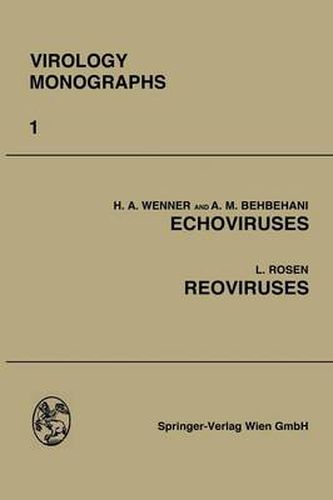Readings Newsletter
Become a Readings Member to make your shopping experience even easier.
Sign in or sign up for free!
You’re not far away from qualifying for FREE standard shipping within Australia
You’ve qualified for FREE standard shipping within Australia
The cart is loading…






This title is printed to order. This book may have been self-published. If so, we cannot guarantee the quality of the content. In the main most books will have gone through the editing process however some may not. We therefore suggest that you be aware of this before ordering this book. If in doubt check either the author or publisher’s details as we are unable to accept any returns unless they are faulty. Please contact us if you have any questions.
The ECHO viruses (enteric cytopathogenic human orphan viruses) comprise a subgroup of the human enteroviruses: all are infectious for human beings. Although several may share common antigens, most are serologically unrelated. They have been grouped together with polio-and Coxsackie viruses because of similar physico-chemical properties, and because they are recoverable from the alimentary tract of human beings. Since 1951 when the first was recognized (ROBBINS et al., 1951),32 more have been discovered. In re cent years 2 members of the group have been placed in other categories: ECHO 10 is now reovirus type 1 (SABIN, 1959), and ECHO 28 is a rhinovirus, provisionally type 1 (TYRRELL and CHANOOK, 1963). During the last 15 years numerous studies have brought to light much information on the properties, ecology and natural history of the ECHO viruses. H. Historical Resume Two conspicuous events fostered the rapid acquisition of knowledge of ECHO viruses. The first was aresurging interest in tissue culture methods permissive of viral growth in vitro (ENDERs et al., 1949); the second was the introduction of mass vaccination against poliomyelitis (FRANCIS et al., 1957). Both events enabled further recognition and delineation of the etiology of illnesses simulating nonparalytic poliomyelitis.
$9.00 standard shipping within Australia
FREE standard shipping within Australia for orders over $100.00
Express & International shipping calculated at checkout
This title is printed to order. This book may have been self-published. If so, we cannot guarantee the quality of the content. In the main most books will have gone through the editing process however some may not. We therefore suggest that you be aware of this before ordering this book. If in doubt check either the author or publisher’s details as we are unable to accept any returns unless they are faulty. Please contact us if you have any questions.
The ECHO viruses (enteric cytopathogenic human orphan viruses) comprise a subgroup of the human enteroviruses: all are infectious for human beings. Although several may share common antigens, most are serologically unrelated. They have been grouped together with polio-and Coxsackie viruses because of similar physico-chemical properties, and because they are recoverable from the alimentary tract of human beings. Since 1951 when the first was recognized (ROBBINS et al., 1951),32 more have been discovered. In re cent years 2 members of the group have been placed in other categories: ECHO 10 is now reovirus type 1 (SABIN, 1959), and ECHO 28 is a rhinovirus, provisionally type 1 (TYRRELL and CHANOOK, 1963). During the last 15 years numerous studies have brought to light much information on the properties, ecology and natural history of the ECHO viruses. H. Historical Resume Two conspicuous events fostered the rapid acquisition of knowledge of ECHO viruses. The first was aresurging interest in tissue culture methods permissive of viral growth in vitro (ENDERs et al., 1949); the second was the introduction of mass vaccination against poliomyelitis (FRANCIS et al., 1957). Both events enabled further recognition and delineation of the etiology of illnesses simulating nonparalytic poliomyelitis.